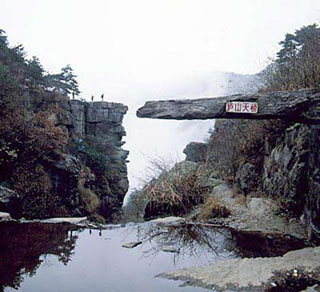| Legole.Com Discover china. Explore the beauty and wonder of the land, people, and culture of China. |
 |
|
|
 |
 Located in the northern part of Jiangxi Province, Mt. Lushan faces the Yangtze River to the north and borders on the east with the largest fresh water lake in China, Poyang Lake. The mountain consists of 99 peaks, the tallest being Dahanyang, rising to the height of 1474 meters (4836 feet) above sea level. With this fantastic blend of mountains, sky, water and cragged cliffs it is one of China's best summer resorts. Located in the northern part of Jiangxi Province, Mt. Lushan faces the Yangtze River to the north and borders on the east with the largest fresh water lake in China, Poyang Lake. The mountain consists of 99 peaks, the tallest being Dahanyang, rising to the height of 1474 meters (4836 feet) above sea level. With this fantastic blend of mountains, sky, water and cragged cliffs it is one of China's best summer resorts.
Mt. Lushan's beauty has been admired for centuries. About 1200 years ago, Li Bai, a master poet of Tang dynasty, portrayed Mt. Lushan in verse, paying homage to the magnificent scenery he saw and enjoyed. He used this area and its spenders as inspiration for many of his over 900 poems.
With 22 waterfalls, 18 rapid torrents, 14 lakes and ponds, the Three Tier Spring is the most outstanding water attraction. A famous saying goes "if there is no Three Tier Spring, Mt. Lushan is not worth visiting". This waterfall plummets 155 meters (over 500 feet) from the pinnacle of Wulaofeng (Peak of Five Old Men), and comes to an abrupt end against the multi-tiered rocks at the cliffs base creating a spectacular screen of mist.
The "Cloud Sea" at Mt. Lushan is impressive. The phrase "Cloud Sea" derives from the mountain being perpetually shrouded in mist. Sudongpo, a well-known poet of the Song Dynasty (A.D.960-1280), honored the "Cloud Sea" of Mt. Lushan for its ever-changing mist in one of his poems. He pointed out, "The failure to get the real looks of the mountain only results in the fact that you are right in the midst of it". By surprising contrast Mt. Lushan ranks as one of the top spots for watching a sunrise.
Admission Fee: 135
East Woods Temple
Situated at the western foot of the mountain, the East Woods Temple was built in 384 A.D. during the East Jin Dynasty. This temple is regarded as the birthplace for Lotus Sect of Buddhism, one of the eight sects of Buddhism. The Lotus Sect of Buddhism was introduced to Japan during the Tang dynasty and remains extremely popular even to this day.
Flower Path
In April, 817A.D., when another celebrated poet of Tang dynasty, Bai Juyi, came to Mt. Lushan. During his visit there he discovered the peach flowers still in full bloom as he ascented the mountain, while in the flatlands the blossoms had since long withered. Delightedly, the poet exclaimed, "The spring was still not gone". Bai Juyi named it "Flower Path" which has now since been designated as a park. The park also retains the remnants of the once great glacier that created this spectacular landscape over two million years ago.
Academy of White Deer Cave
In the valley of Wulanfeng stands one of the oldest institutions for higher learning in China. It was established in the Tang Dynasty during the 9th century. The teachings were first centered on the teachings of Confucius. The founder raised a pet white deer, thus its name "Academy of White Deer Cave". In the courtyard there is the Tablet Corridor, The Sacred Gate of Ceremony and White Deer Cave. |
 |
|
|
 |
|
